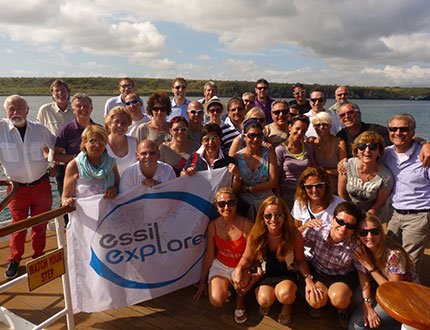
Epson presenta Moverio Bt-100Epson presents Moverio BT-100
Un dispositivo pensato per un utilizzo educational e business più che multimediale Uno schermo da 320 pollici misura all'incirca 7 metri (larghezza) per 4 (altezza). Come portarselo dietro? Infilandolo dentro a un paio di occhiali. Non è una battuta, né fantascienza. Parliamo dell' "occhiale visore" di Epson, il Moverio Bt-100. Non si tratta ancora del Project Glass svelato da Google ma è un prodotto reale. Nelle aste laterali dell' occhiale (piuttosto ingombrante e non proprio leggero, 240 grammi, e inoltre tende a scivolare sul naso) ci sono due pico-proiettori Lcd, che mandano l' immagine su due schermi da 0,52 pollici collocati davanti agli occhi. L' effetto percettivo è quello di guardare un display enorme, fino ai sopracitati 320 pollici osservati a una distanza (virtuale) di 7 metri. Poiché il visore è trasparente, l' immagine è proiettata sul fondale dell' ambiente in cui ci si trova: meglio che non sia troppo luminoso. In caso contrario (all' aperto), si può montare una lente scura, ma sempre trasparente, che aumenta il contrasto. Il display è anche 3D: l'effetto delle tre dimensioni è buono ma un certo fastidio alla vista è assicurato. Troppi stimoli: quelli dell'ambiente circostante sul fondale e in più quelli di un video 3D che già di solito non tutti digeriscono. Epson Moverio è di fatto uno smartphone Android 2.2, con interfaccia personalizzata da Epson. Le app si comandano attraverso un trackpad touch, collegato via cavo agli occhiali, purtroppo non facilissimo da usare: non recepisce tocchi «multitouch» e in generale è poco reattivo. La connettività è solo wi-fi. Per navigare in mobilità dovrete accendere un hotspot wi-fi sul vostro smartphone. L' oggetto non è pensato tanto per la multimedialità, quanto piuttosto per un utilizzo educational e soprattutto business. Ad esempio, un manager che vuole consultare documenti in pubblico con la massima privacy: i contenuti sono visualizzabili solo da chi indossa il visore. Purtroppo alcuni aspetti ne appesantiscono in maniera decisiva l' esperienza d' uso. E non siamo di fronte a un prodotto che punta sulla realtà aumentata, come dovrebbe fare il progetto di Google, perché mancano software e app pensati apposta per l'integrazione tra reale e virtuale. Ma nonostante tutto questa categoria di oggetti è uno squarcio sul futuro. La strada dello sviluppo per arrivare a qualcosa di davvero usabile e appetibile è però ancora lunga. Fonte: il corriere online A multimedia device that's more for educational and business use A 320-inch screen measuring about 7 meters (width) by 4 (height). How can you carry it? By putting it inside a pair of glasses. No, it's not a joke or science fiction. It's Epson's "visor eyewear", the Moverio BT-100. Neither is it the Project Glass unveiled by Google, but a real product. The eyewear (which is fairly big and weighing in at 240 grams it's not exactly light and tends to slide down your nose) has two LCD pico projectors in the temples that send images to two 0.52-inch screens in front of the eyes. The perceived effect is an enormous display of about 320 inches seen from a (virtual) distance of 7 meters. Because the visor is transparent, the image is projected onto the actual environment, which shouldn't be too bright. Alternatively (outdoors), transparent dark lenses can be added to increase contrast. The display is also 3D: the three dimensional effect is good, but a certain amount of visual interference is guaranteed. There is too much stimulus from the physical surroundings and 3D video that not everyone enjoys in any case. Epson Moverio is in fact an Android 2.2 smartphone with Epson's personalized interface. The apps are controlled by a trackpad cable-connected to the eyewear and unfortunately it's not very easy to use: it doesn't have multi-touch and it's not very responsive in general. Connectivity is WI-FI only. To navigate on the go you have to activate a WI-FI hotspot on your smartphone. This is not so much a multimedia device as one for educational and, primarily, business use. For example, a manager who wants to look at documents in public with maximum privacy: the contents can be seen only by the person wearing the visor. Unfortunately, some aspects make it much more complicated to use. And this is not a product that is aiming for augmented reality, as the Google project should, because no software or apps have been designed specifically for real and virtual integration. Despite everything, this category of device is a glimpse of the future. But the development of something that is really usable and appealing still has a long way to go. Source: il corriere online



